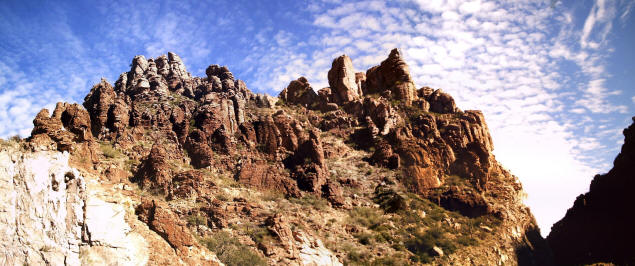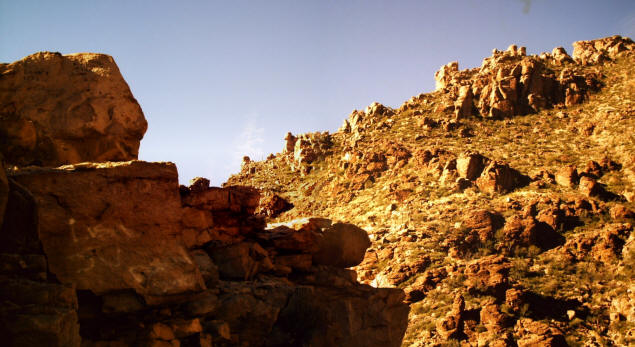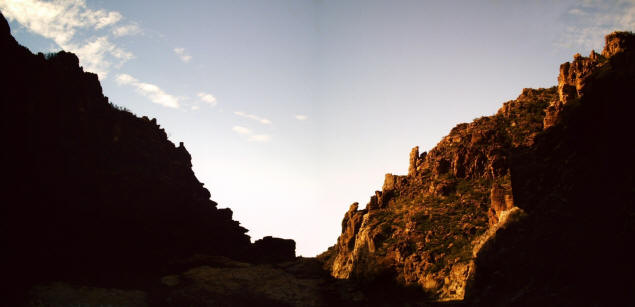| By: Paul S. Cilwa | Viewed: 4/23/2024 Occurred: 12/21/2008 |
Page Views: 1724 | |
| Topics: #Superior #Arizona #QueenCreekGorge #Travel #Photography | |||
| All about my drive through one of Arizona's many scenic gems. | |||
About 30 miles east of where we live, along US 60, lies the little mining town of Superior, Arizona. It's a relatively unremarkable place, but just a few miles past it US 60 winds its way into a gorge dug eons ago by Queen Creek, which eventually winds its way into the Valley and gives its name to a smaller housing development that is one of the dozens of Phoenix suburbs.
I've passed through Queen Creek Canyon probably a dozen times, and every time I wanted to take pictures. But either I didn't have a decent camera, or the light wasn't right, or I was in a hurry to get somewhere else. This morning I got up early for the express purpose of running out there in the SUV and getting a few shots of this exquisite bit of Arizona that is largely unknown to most people, other than those who live in the immediate area.
First, to find it: US 60 runs right through Phoenix—in fact, for a lengthy stretch it shares tarmac with I-10. You just keep going east until you get to Superior, then keep going east just a few miles more.

The road is in excellent condition and there are plenty of turnoffs to allow for safe photography. The first thing you'll want to do is turn around and get a shot of Superior, nestled in the crook of the canyon's apron.
At this point the sides of the gorge haven't pushed in close enough to make you feel squeezed; but there are still plenty of impressive, near vertical rock walls to provide of hint of that which is to come.
Geologically, the strata of this area are jumbled; so while some layers have been turned completely vertical, as in the above photo, others are canted. Remember, every layer was once absolutely flat sea bottom, a fact which is easily verified by examining some of the exposed limestone, such as is shown below, for numerous microscopic skeletons of ancient sea creatures.
Continuing along the road, you'll encounter the so-called "million-dollar tunnel" that was carved out over fifty years ago when US 60 was a major route.

This whole area was once flat; but wind and water erosion carved out the fantastic shapes we now see on either side of the road. Reaching like petrified giants' fingers to the sky, they are called "hoodoos" and contribute to the other-worldly feeling of the place.

Indeed, the hills of Mars must look much like Queen Creek Canyon.

If you want to catch interesting photos of pretty much anything, but especially mountainous regions and rock formations, you generally want to get your shots in when the sun is low. At noon when the sun is directly overhead, photos tend to look rather flat and lifeless. At 10 or so in the morning, on the other hand, each rock stands out.
There's also a rule of thumb that you want the sun "over your shoulder" when taking a picture. This is useful advice when taking photos of people, but with landscapes, a shot toward the sun might well be far more breathtaking.
As the canyon narrows and becomes more of a gorge, there are little stagnant pools that is all that is left of Queen Creek in the fall. A few months from now, when the high country snows melt, the creek will roar with the rush of icy water heading toward the desert valley below.
We don't get a lot of trees changing color around here, but it was fun to find one little tree clinging to life on the edge of the creek, its leaves forlornly dressed in what passes for its finest.
As the sun rose higher and the shadows became less dramatic, I turned around and headed toward home. I now had the opportunity to pick more detail out of the hillside, although the photo below required me to digitally brighten only the hill to avoid washing out the sky.
Finally, one last panorama before heading home.

The map indicates a lot of interesting side roads that cried out to be explored. Hopefully I'll be able to do some of that on a future trip.





